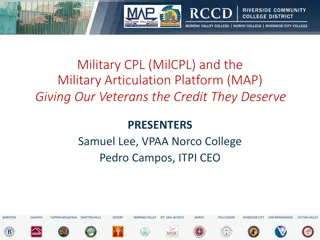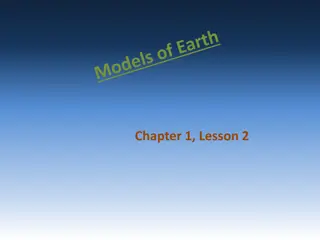Exploring Kei Miller's "The Cartographer Tries to Map a Way to Zion
Kei Miller's collection offers a rich exploration of poetry, culture, and identity through the voices of a cartographer, a rastaman, and a narrator. The poems delve into themes of language, borders, and the poetic process itself, inviting readers to consider the intersections of literary, political, historical, and philosophical dimensions. Miller's work presents a unique blend of styles and ideas that resonate with students and offer a multi-faceted approach to understanding poetry.
Download Presentation

Please find below an Image/Link to download the presentation.
The content on the website is provided AS IS for your information and personal use only. It may not be sold, licensed, or shared on other websites without obtaining consent from the author. Download presentation by click this link. If you encounter any issues during the download, it is possible that the publisher has removed the file from their server.
E N D
Presentation Transcript
Kei Miller The Cartographer Tries to Map a Way to Zion Nick Baker
Kei Miller: The Cartographer Tries to Map a Way to Zion Why should you consider teaching this collection? Ideas, issues, style and poetic features, contexts Approaches and sample essay questions
Why might you choose this text? A lively, uplifting collection that enables students to explore poetry as intellectual, sensory, exploratory & liberating A poet divided between two cultures and two languages - this should resonate with OIB students A work that can be approached from many directions: literary, political, historical, linguistic & etymological, philosophical, anthropological, scientific, musical and fun A work that is about itself: the metapoetic notion of the poem itself as a map of the poet s world A work whose style and form fuse with its ideas so it s easy for students to talk about the literary dimension and the voice (in fact, it s hard to avoid)
Some relevant notions of poetry Frost: Poetry is what is lost in translation As a tool of cognition, poetry beats any existing form of analysis (a) because it pares down our reality to its linguistic essentials, whose interplay, be it clash or fusion, yields epiphany or revelation, and (b) because it exploits the rhythmic and euphonic properties of the language that in themselves are revelatory - Joseph Brodsky Wordsworth: subjects from common life the real language of men Shelley: Poets are the unacknowledged legislators of the world : a challenge to conventional forms of power
The Cartographer and the Rastaman Two types of knowledge Two visions of the word, and the world A conversation between two voices and two visions, mediated by a narrator The world we live in constrained or liberated by the language we use to define it and to live within it The challenging of the borders between the two voices
Voices Cartographer, rastaman, narrator The cartographer, the rastaman no names The definite article might suggest representative figures, or archetypes within the self: an internal dialogue about cultural and personal identity Despite the apparent opposition, there are moments when the voices open to each other and reveal unexpected facets. The rastaman has a PhD; the cartographer realises that Zion is not really a place A dialogue of principles within the self
The political dimension Map making as colonial expression of power and ownership of land Language and voice as political constructs: the rastaman calls the cartographer a map maker, avoiding the latinate language of conquest; the cartographer uses latinate language Rastafarian dialect forms words and phrases following principles of ideology and pleasure
Mapping Cartographer: scientific, physical geography, borders, power, administration (what the rastaman calls the viral spread of governments ) Rastaman: spiritual geography (how to get to Zion), what gives an identity to a place: the people, their words, their beliefs The limits of each form of mapping: the cartographer can t map a way to Zion because it isn t a place but a state of being; he ultimately realises this: How does one map a place/ that is not quite a place? How does one draw/towards the heart?
Maps and postcolonial theory (what I do is science ) If we are truly concerned with the social consequences of what happens when we makea map, then we might also decide that cartography is too important to be left entirely to cartographers. J.B. Harley, The New Nature of Maps (2001) Maps can inculcate us into seeing and representing the world in highly selective (and, for the powerful, felicitous) ways. D. Clayton, Snapshots of a Moving Target
Mapping The cartographer says What I do is science. I show the earth as it is, without bias. The rastaman thinks, draw me a map of what you see then I will draw a map of what you never see and guess me whose map will be bigger than whose? Guess me whose map will tell the larger truth?
Rastafarian culture Belief in the beauty of the black Jamaican s African heritage Zion as the promised land, which is Ethiopia; belief in repatriation to Ethiopia Ras tafari Haile Selassie I of Ethiopia (1892-1975), conquering Lion of the Tribe of Judah (hence the lion symbol of rastafarians) seen as the returning biblical Messiah, God incarnate. He was a member of the Solomonic dynasty, claiming descent from King Solomon of Israel and the Queen of Sheba Reggae; marijuana (the wisdom weed or the holy herb) Belief that the world is a perpetual work of creation: in this collection, it is described as the shrug of Jah
Rastafarian language The colonising language is appropriated by the colonised and transformed into a new cultural form of expression. English words in Rastafari become positive expression of Rastafarian concepts such as unity, peace and love. Thus understanding becomes overstanding or innerstanding Thus oppression becomes downpression International becomes outernational the world outside, unrelated to Jah Everlasting life becomes everliving life because last suggests the end of life, which most rastas don t believe in Words are re-formed to reflect ideology and belief The importance of the pleasure of discourse playfulness of language and importance of rhythm
I and I The one-ness of Jah (God) in every person; the idea that all people are united and that God is in all of us: we are not separate ( I ) but in mystic union ( I and I ) I-man (inner man), Inity (unity), I-formant (friendly informant)
Babylon Any force that represses or oppresses the innocent: often used to refer to the police or other governmental institutions this island spreads out as a palimpsest / of maps: for here is Bethlehem; here is Tel Aviv; here / is Gaza; also Edinburgh; Aberdeen [...] all of here is Babylon Map was just Babylon s most vampiric orthography. Better I&I never learn fi overstand what was nutt n more than de downpressor s pig latin
The medium is the message: two voices, two sets of values & attitudes Rastafarian: the language expresses pleasure, creativity, human values, the spiritual, the local and a sense that the positive should be reinforced and the negative or repressive opposed. Cartographer: the language of Europe, conquest, borders, power, administration and logic. Latinate. The institution and the nation rather than the individual and local Dangers of stereotyping: is this an internal dialogue? Are both characters the poet? The rastaman has a PhD; the Cartographer understands that Zion is not exactly a place Postcolonial identity: both European and local, the hybrid reclaiming the language of the coloniser
The limitations of any system of values or ideology Both the rastaman and the cartographer see and overflow the limits of their own system The cartographer wishes to put right historical injustices through mapping, straightening roads as if in drawing/he might erase a small bit of history s disgrace Writing becomes a means of fracturing or escaping the world we tend to embed ourselves in (Michael Rose-Steel) Poetry may be a form of mapping that overcomes its own limits
Poetry about poetry Balance between eternal creation ( the shrug of Jah ) and the limits to creation ( Establishing the Metre ): borders and measures in map making, the world and poetry.
Approaches Translate one of the Rastaman s poems into the Cartographer s English. What has been gained, and what lost? Who are your inner cartographer and your inner rastaman? Write a poem that gives voice to two different parts of yourself Explore the references to music in the poems. What do the choices of music bring to the poems?
Research and give a presentation on: the language of the rastaman in the collection the political dialogue of the rastaman and the cartographer in this collection Reggae The history of map-making The history of Jamaica as represented in the collection Zion or Babylon as represented in the collection
Essays Unity through opposition : how far would you accept this summary of the collection? The ideas of this collection are embodied in the voices of the rastaman and the cartographer . How far would you agree? In this collection, the political and the personal are inseparable . How far would you agree? How important are ideas of borders and limits in this collection? To what extent does this collection suggest that language is in itself political? How far, and in what ways, does this collection explore a clash of value systems? How far, and in what ways, does this collection explore the relationship between the visible world and the unseen world? Would you consider this collection primarily angry or celebratory?























